-

高教版中职数学基础模块下册:10.1《计数原理》教学设计
授课 日期 班级16高造价 课题: §10.1 计数原理 教学目的要求: 1.掌握分类计数原理与分步计数原理的概念和区别; 2.能利用两个原理分析和解决一些简单的应用问题; 3.通过对一些应用问题的分析,培养自己的归纳概括和逻辑判断能力. 教学重点、难点: 两个原理的概念与区别 授课方法: 任务驱动法 小组合作学习法 教学参考及教具(含多媒体教学设备): 《单招教学大纲》、课件 授课执行情况及分析: 板书设计或授课提纲 §10.1 计数原理 1、加法原理 2、乘法原理 3、两个原理的区别
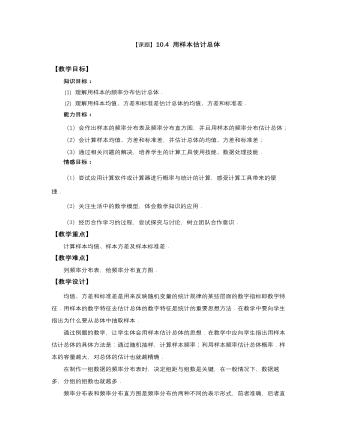
高教版中职数学基础模块下册:10.4《用样本估计总体》教学设计
教 学 过 程教师 行为学生 行为教学 意图时间 *揭示课题 10.4 用样本估计总体 *创设情境 兴趣导入 【知识回顾】 初中我们曾经学习过频数分布图和频数分布表,利用它们可以清楚地看到数据分布在各个组内的个数. 【知识巩固】 例1 某工厂从去年全年生产某种零件的日产记录(件)中随机抽取30份,得到以下数据: 346 345 347 357 349 352 341 345 358 350 354 344 346 342 345 358 348 345 346 357 350 345 352 349 346 356 351 355 352 348 列出频率分布表. 解 分析样本的数据.其最大值是358,最小值是341,它们的差是358-341=17.取组距为3,确定分点,将数据分为6组. 列出频数分布表 【小提示】 设定分点数值时需要考虑分点值不要与样本数据重合. 分 组频 数 累 计频 数340.5~343.5┬2343.5~346.5正 正10346.5~349.5正5349.5~352.5正  ̄6352.5~355.5┬2355.5~358.5正5合 计3030 介绍 质疑 引领 分析 讲解 说明 了解 观察 思考 解答 启发 学生思考 0 10*动脑思考 探索新知 【新知识】 各组内数据的个数,叫做该组的频数.每组的频数与全体数据的个数之比叫做该组的频率. 计算上面频数分布表中各组的频率,得到频率分布表如表10-8所示. 表10-8 分 组频 数频 率340.5~343.520.067343.5~346.5100.333346.5~349.550.167349.5~352.560.2352.5~355.520.067355.5~358.550.166合 计301.000 根据频率分布表,可以画出频率分布直方图(如图10-4). 图10-4 频率分布直方图的横轴表示数据分组情况,以组距为单位;纵轴表示频率与组距之比.因此,某一组距的频率数值上等于对应矩形的面积. 【想一想】 各小矩形的面积之和应该等于1.为什么呢? 【新知识】 图10-4显示,日产量为344~346件的天数最多,其频率等于该矩形的面积,即 . 根据样本的数据,可以推测,去年的生产这种零件情况:去年约有的天数日产量为344~346件. 频率分布直方图可以直观地反映样本数据的分布情况.由此可以推断和估计总体中某事件发生的概率.样本选择得恰当,这种估计是比较可信的. 如上所述,用样本的频率分布估计总体的步骤为: (1) 选择恰当的抽样方法得到样本数据; (2) 计算数据最大值和最小值、确定组距和组数,确定分点并列出频率分布表; (3) 绘制频率分布直方图; (4) 观察频率分布表与频率分布直方图,根据样本的频率分布,估计总体中某事件发生的概率. 【软件链接】 利用与教材配套的软件(也可以使用其他软件),可以方便的绘制样本数据的频率分布直方图,如图10-5所示. 图10?5 讲解 说明 引领 分析 仔细 分析 关键 语句 观察 理解 记忆 带领 学生 分析 25
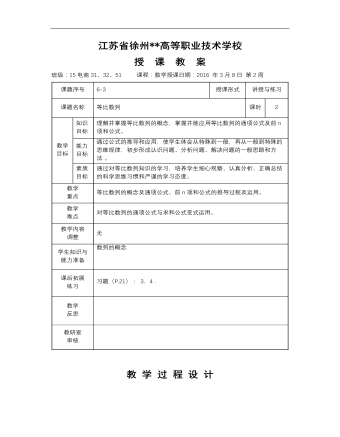
高教版中职数学基础模块下册:6.3《等比数列》教学设计
课题序号6-3授课形式讲授与练习课题名称等比数列课时2教学 目标知识 目标理解并掌握等比数列的概念,掌握并能应用等比数列的通项公式及前n项和公式。能力 目标通过公式的推导和应用,使学生体会从特殊到一般,再从一般到特殊的思维规律,初步形成认识问题、分析问题、解决问题的一般思路和方法 。素质 目标通过对等比数列知识的学习,培养学生细心观察、认真分析、正确总结的科学思维习惯和严谨的学习态度。教学 重点等比数列的概念及通项公式、前n项和公式的推导过程及运用。教学 难点对等比数列的通项公式与求和公式变式运用。教学内容 调整无学生知识与 能力准备数列的概念课后拓展 练习 习题(P.21): 3,4.教学 反思 教研室 审核
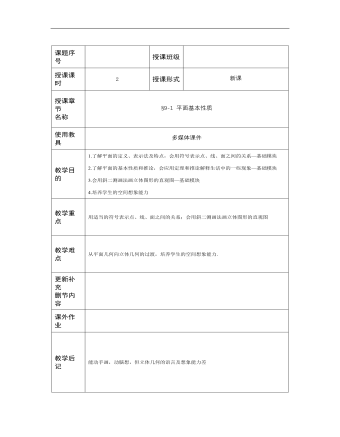
高教版中职数学基础模块下册:9.1《平面的基本性质》教学设计
课题序号 授课班级 授课课时2授课形式新课授课章节 名称§9-1 平面基本性质使用教具多媒体课件教学目的1.了解平面的定义、表示法及特点,会用符号表示点、线、面之间的关系—基础模块 2.了解平面的基本性质和推论,会应用定理和推论解释生活中的一些现象—基础模块 3.会用斜二测画法画立体图形的直观图—基础模块 4.培养学生的空间想象能力教学重点用适当的符号表示点、线、面之间的关系;会用斜二测画法画立体图形的直观图教学难点从平面几何向立体几何的过渡,培养学生的空间想象能力.更新补充 删节内容 课外作业 教学后记能动手画,动脑想,但立体几何的语言及想象能力差
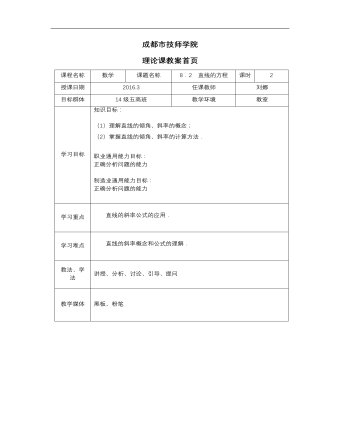
高教版中职数学基础模块下册:8.2《直线的方程》教学设计
课程名称数学课题名称8.2 直线的方程课时2授课日期2016.3任课教师刘娜目标群体14级五高班教学环境教室学习目标知识目标: (1)理解直线的倾角、斜率的概念; (2)掌握直线的倾角、斜率的计算方法. 职业通用能力目标: 正确分析问题的能力 制造业通用能力目标: 正确分析问题的能力学习重点直线的斜率公式的应用.学习难点直线的斜率概念和公式的理解.教法、学法讲授、分析、讨论、引导、提问教学媒体黑板、粉笔
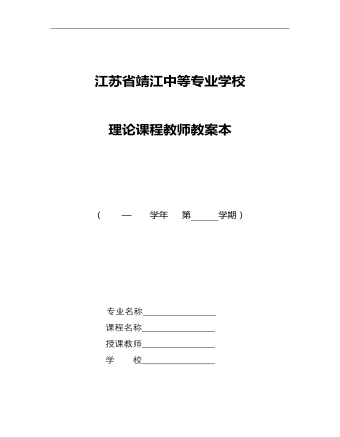
高教版中职数学基础模块下册:9.5《柱、锥、球及其简单组合体》教学设计
课题序号 授课班级 授课课时2授课形式 教学方法 授课章节 名称9.5柱、锥、球及其组合体使用教具 教学目的1、使学生认识柱、锥、球及其组合体的结构特征,并能运用这些特征描述生活中简单物体的结构。 2、让学生了解柱、锥、球的侧面积和体积的计算公式。 3、培养学生观察能力、计算能力。
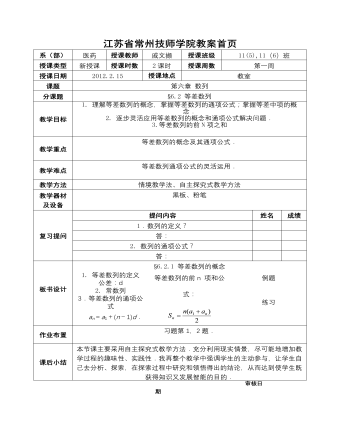
高教版中职数学基础模块下册:6.2《等差数列》教学设计
系(部)医药授课教师戚文撷授课班级11(5),11(6)班授课类型新授课授课时数2课时授课周数第一周授课日期2012.2.15授课地点 教室课题第六章数列分课题§6.2 等差数列教学目标1. 理解等差数列的概念,掌握等差数列的通项公式;掌握等差中项的概念. 2. 逐步灵活应用等差数列的概念和通项公式解决问题. 3.等差数列的前N项之和 . 4.培养学生分析、比较、归纳的逻辑思维能力. . 2. 3.教学重点等差数列的概念及其通项公式. 教学难点等差数列通项公式的灵活运用. 教学方法情境教学法、自主探究式教学方法教学器材及设备黑板、粉笔复习提问提问内容姓名成绩1.数列的定义? 答: 2. 数列的通项公式? 答: 板书设计 §6.2.1等差数列的概念 1. 1.等差数列的定义 公差:d 2.常数列 3.等差数列的通项公式 an=a1+(n-1)d. 等差数列的前n 项和公式: 例题 练习作业布置习题第1,2题.课后小结本节课主要采用自主探究式教学方法.充分利用现实情景,尽可能地增加教学过程的趣味性、实践性.我再整个教学中强调学生的主动参与,让学生自己去分析、探索,在探索过程中研究和领悟得出的结论,从而达到使学生既获得知识又发展智能的目的.
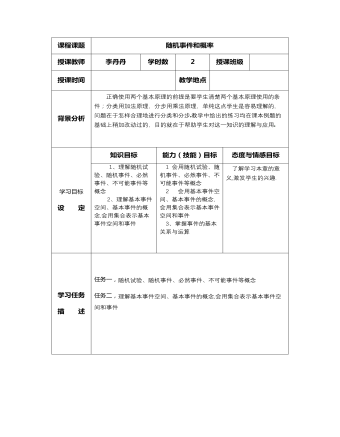
高教版中职数学基础模块下册:10.2《概率》教学设计
课程课题随机事件和概率授课教师李丹丹学时数2授课班级 授课时间 教学地点 背景分析正确使用两个基本原理的前提是要学生清楚两个基本原理使用的条件;分类用加法原理,分步用乘法原理,单纯这点学生是容易理解的,问题在于怎样合理地进行分类和分步教学中给出的练习均在课本例题的基础上稍加改动过的,目的就在于帮助学生对这一知识的理解与应用 学习目标 设 定知识目标能力(技能)目标态度与情感目标1、理解随机试验、随机事件、必然事件、不可能事件等概念 2、理解基本事件空间、基本事件的概念,会用集合表示基本事件空间和事件 1 会用随机试验、随机事件、必然事件、不可能事件等概念 2 会用基本事件空间、基本事件的概念,会用集合表示基本事件空间和事件 3、掌握事件的基本关系与运算 了解学习本章的意义,激发学生的兴趣. 学习任务 描 述 任务一,随机试验、随机事件、必然事件、不可能事件等概念 任务二,理解基本事件空间、基本事件的概念,会用集合表示基本事件空间和事件
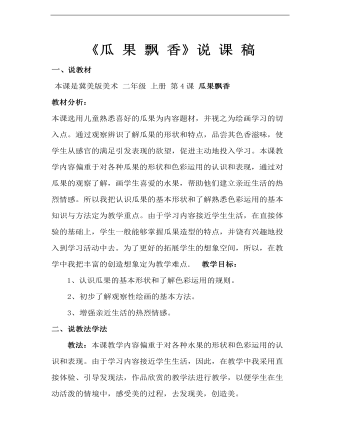
小学美术冀美版二年级上册《4瓜果飘香》说课稿
二、说教法学法教法:本课教学内容偏重于对各种水果的形状和色彩运用的认识和表现。由于学习内容接近学生生活,因此,在教学中我采用直接体验、引导发现法,作品欣赏的教学法进行教学,以便学生在生动活泼的情境中,感受美的过程,去发现美,创造美。
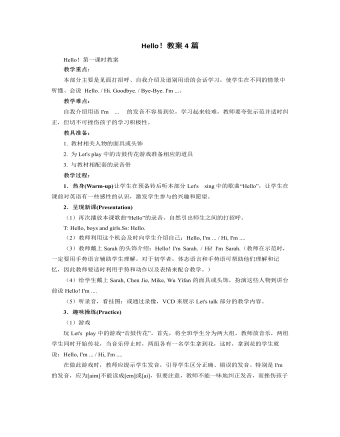
人教版新课标PEP小学英语三年级上册Hello!教案4篇
(3)通过游戏Simon says 来练习以show, open, close, put, carry 所引导的祈使句。教师发指令学生做动作。但只有听到老师带有Simon says的指令时,才能做出相应的动作,否则就是失败。失败的同学退出游戏。(4)听Let's chant的录音,学生边听边做,逐渐过渡成边听边说边做,最后独立说做,并进行比赛。4. 课堂评价(Assessment)做活动手册本单元第5部分练习。学生根据录音,圈出所听到的文具。具体方法和步骤参考如下:(1)学生看图,用英语说出图中每样文具物品。(2)教师讲解题目的意思并指导做的方法。(3)学生听录音做练习。(4)再放录音,在教师的指导下让学生一句一句地跟读并互相核对答案,并说出所圈的文具,再通过给花朵涂色进行自我评价。5. 扩展性活动(Extensive activities)选词游戏。将学生分为六组,每组各派一个选手,教师说单词,选手快步跑到讲台前,找到所说单词,并举起大声读出,正确为胜。
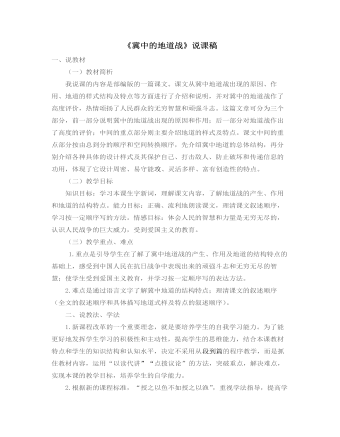
部编人教版五年级上册《 冀中的地道战》说课稿
一、说教材 (一)教材简析我说课的内容是部编版的一篇课文。课文从冀中地道战出现的原因、作用、地道的样式结构及特点等方面进行了介绍和说明,并对冀中的地道战作了高度评价,热情颂扬了人民群众的无穷智慧和顽强斗志。这篇文章可分为三个部分,前一部分说明冀中的地道战出现的原因和作用;后一部分对地道战作出了高度的评价;中间的重点部分则主要介绍地道的样式及特点。课文中间的重点部分按由总到分的顺序和空间转换顺序,先介绍冀中地道的总体结构,再分别介绍各种具体的设计样式及其保护自己、打击敌人、防止破坏和传递信息的功用,体现了它设计周密、易守能攻、灵活多样、富有创造性的特点。(二)教学目标知识目标:学习本课生字新词,理解课文内容,了解地道战的产生、作用和地道的结构特点。能力目标:正确、流利地朗读课文,理清课文叙述顺序,学习按一定顺序写的方法。情感目标:体会人民的智慧和力量是无穷无尽的,认识人民战争的巨大威力,受到爱国主义的教育。
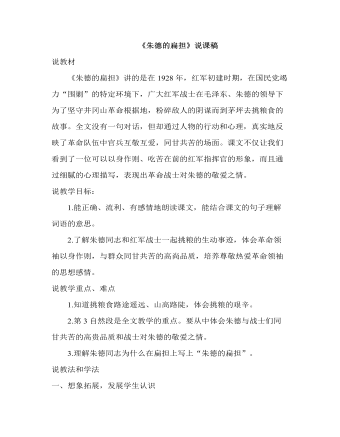
部编人教版二年级上册《朱德的扁担》说课稿
《语文课程标准》指出:“语文课程丰富的人文内涵对人们的精神领域的影响是深广的,学生对语文材料的反映往往也是多元的。”启发学生借助教材展开想象,并通过换位思考,体验人物内心,从吸收至倾吐,发展学生的语言,发展学生的思维,从而切实提高学生的认识,指导他们的生活。首先在教学过程中引导学生主动思维,激发学生的情感,从自己的身边去发现,去对比,加强对当时革命状况的了解,从而引发对革命事业崇敬之情。其次在教学的过程中,教师创设这样一个情境,把学生置身于故事所在的背景中,使得学生把自己当作是故事中的一员来参与,参与其中的艰辛,参与其中的心理过程,这样不但有助于教学的开展,而且也可以让学生能够更加的感同身受,激发学生对革命领导人的尊敬与热爱。
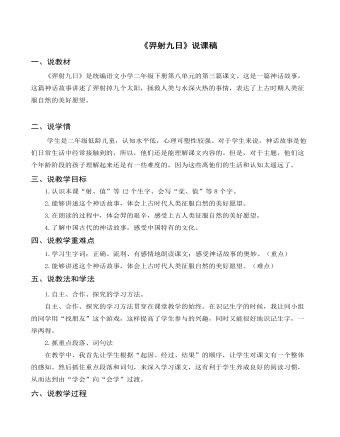
(说课稿)《羿射九日》部编人教版二年级上册语文
三、说教学目标1.认识本课“射、值”等12个生字、会写“觉、值”等8个字。2.能够讲述这个神话故事,体会上古时代人类征服自然的美好愿望。3.在朗读的过程中,体会羿的艰辛,感受上古人类征服自然的美好愿望。4.了解中国古代的神话故事,感受中国特有的文化。四、说教学重难点1.学习生字词;正确、流利、有感情地朗读课文;感受神话故事的奥妙。(重点) 2.能够讲述这个神话故事,体会上古时代人类征服自然的美好愿望。(难点)五、说教法和学法1.自主、合作、探究的学习方法。自主、合作、探究的学习方法贯穿在课堂教学的始终。在识记生字的时候,我让同小组的同学用“找朋友”这个游戏,这样提高了学生参与的兴趣,同时又能很好地识记生字,一举两得。2.抓重点段落、词句法在教学中,我首先让学生根据“起因、经过、结果”的顺序,让学生对课文有一个整体的感知。然后抓住重点段落和词句,来深入学习课文,这有利于学生养成良好的阅读习惯,从而达到由“学会”向“会学”过渡。
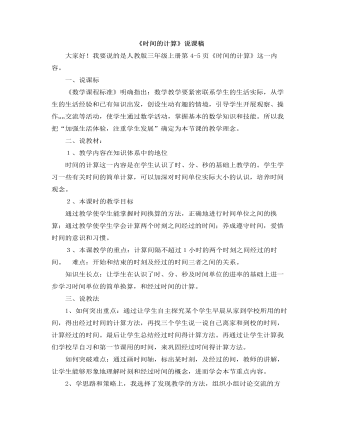
小学数学人教版三年级上册《时间的计算》说课稿
一、说课标《数学课程标准》明确指出:数学教学要紧密联系学生的生活实际,从学生的生活经验和已有知识出发,创设生动有趣的情境,引导学生开展观察、操作??交流等活动,使学生通过数学活动,掌握基本的数学知识和技能。所以我把“加强生活体验,注重学生发展”确定为本节课的教学理念。二、说教材:1、教学内容在知识体系中的地位 时间的计算这一内容是在学生认识了时、分、秒的基础上教学的。学生学习一些有关时间的简单计算,可以加深对时间单位实际大小的认识,培养时间观念。2、本课时的教学目标 通过教学使学生能掌握时间换算的方法,正确地进行时间单位之间的换算;通过教学使学生学会计算两个时刻之间经过的时间;养成遵守时间,爱惜时间的意识和习惯。3、本课教学的重点:计算间隔不超过1小时的两个时刻之间经过的时间。 难点:开始和结束的时刻及经过的时间三者之间的关系。知识生长点:让学生在认识了时、分、秒及时间单位的进率的基础上进一步学习时间单位的简单换算,和经过时间的计算。
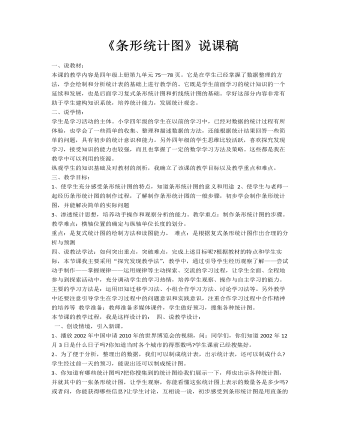
小学数学人教版四年级上册《条形统计图》说课稿
二、说学情:?学生是学习活动的主体。小学四年级的学生在以前的学习中,已经对数据的统计过程有所体验,也学会了一些简单的收集、整理和描述数据的方法,还能根据统计结果回答一些简单的问题,具有初步的统计意识和能力。另外四年级的学生思维比较活跃,喜欢探究发现学习,接受知识的能力也较强,而且也掌握了一定的数学学习方法及策略。这些都是我在教学中可以利用的资源。?纵观学生的知识基础及对教材的剖析,我确立了该课的教学目标以及教学重点和难点。?三、教学目标:?1、使学生充分感受条形统计图的特点,知道条形统计图的意义和用途?2、使学生与老师一起经历条形统计图的制作过程,了解制作条形统计图的一般步骤,初步学会制作条形统计图,并能解决简单的实际问题
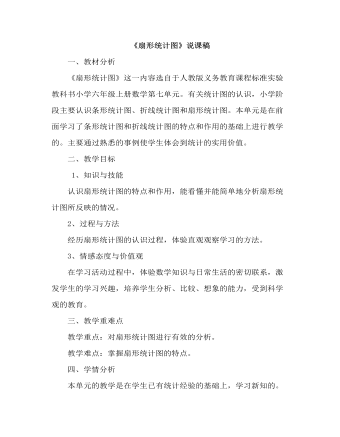
小学数学人教版六年级上册《扇形统计图》说课稿
一、教材分析《扇形统计图》这一内容选自于人教版义务教育课程标准实验教科书小学六年级上册数学第七单元。有关统计图的认识,小学阶段主要认识条形统计图、折线统计图和扇形统计图。本单元是在前面学习了条形统计图和折线统计图的特点和作用的基础上进行教学的。主要通过熟悉的事例使学生体会到统计的实用价值。二、教学目标1、知识与技能认识扇形统计图的特点和作用,能看懂并能简单地分析扇形统计图所反映的情况。2、过程与方法经历扇形统计图的认识过程,体验直观观察学习的方法。3、情感态度与价值观在学习活动过程中,体验数学知识与日常生活的密切联系,激发学生的学习兴趣,培养学生分析、比较、想象的能力,受到科学观的教育。
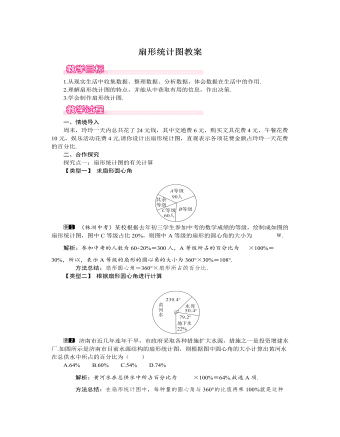
北师大初中七年级数学上册扇形统计图教案1
根据题意,得34%x-18%x=160,解得x=1000.所以48%x=48%×1000=480(公顷),18%x=18%×1000=180(公顷),34%x=34%×1000=340(公顷).答:玉米种了340公顷,高粱种了180公顷,水稻种了480公顷.方法总结:从扇形统计图中获取正确的信息是解题的关键.语文老师对班上学生的课外阅读情况做了调查,并请数学老师制作了如图所示的统计图.(1)哪种书籍最受欢迎?(2)哪两种书籍受欢迎程度差不多?(3)图中扇形分别表示什么?(4)图中的各个百分比如何得到?所有的百分比之和是多少?解:(1)科幻书籍最受欢迎,可从扇形的大小或图中百分比的大小得出.(2)科普书籍和武侠书籍受欢迎程度差不多,可从图中扇形大小或图中所标百分比的大小得出.(3)图中扇形分别代表了最喜欢某种书籍的人数占全班人数的百分比.(4)用最喜欢某种书籍的人数比全班的总人数即可得各个百分比,所有的百分比之和为1.方法总结:由扇形统计图获取信息时,一定要明确各个项目和它们所占圆面的百分比.
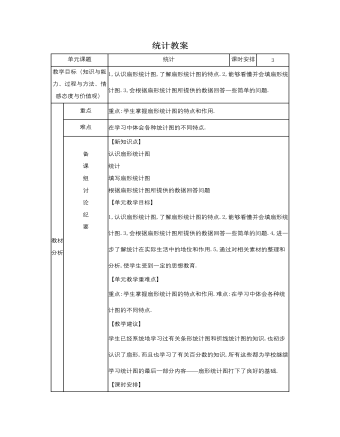
人教版新课标小学数学六年级上册统计教案
【新知识点】认识扇形统计图统计填写扇形统计图根据扇形统计图所提供的数据回答问题【单元教学目标】1,认识扇形统计图,了解扇形统计图的特点.2,能够看懂并会填扇形统计图.3,会根据扇形统计图所提供的数据回答一些简单的问题.4,进一步了解统计在实际生活中的地位和作用.5,通过对相关素材的整理和分析,使学生受到一定的思想教育.【单元教学重难点】重点:学生掌握扇形统计图的特点和作用.难点:在学习中体会各种统计图的不同特点.【教学建议】学生已经系统地学习过有关条形统计图和折线统计图的知识,也初步认识了扇形,而且也学习了有关百分数的知识,所有这些都为学校继续学习统计图的最后一部分内容——扇形统计图打下了良好的基础.【课时安排】
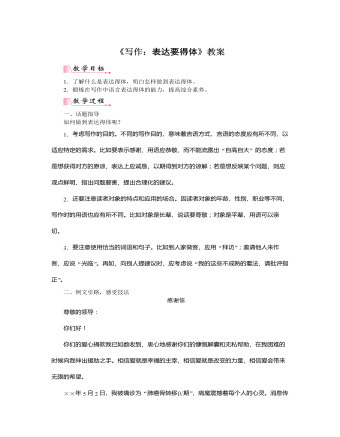
部编版语文八年级上册《写作:表达要得体》教案
(5)在右下方写提出倡议的单位名称或个人姓名,在名称或姓名下写日期。本次写作关键是正文部分,应先写清环境保护倡议活动的原因和现实背景,再写发出倡议的具体措施。最后总结一下,表明倡议活动的意义及倡议者的希望等。四、参考范文环境保护倡议书尊敬的领导、老师,亲爱的同学们:你们好!蓝天碧水、明媚阳光、鸟语花香、清新空气是构成我们梦寐以求的优美家园不可或缺的自然条件,但是废气、污水、白色垃圾、重金属等污染物侵蚀了这一切,环境污染已危及人类的健康与生存。有谁会想到,那些泛着刺眼的白色的饭盒会污染多少土地?有谁会想到,那些废弃的塑料袋随风飘散在空中,会污染多少城市和乡村?保护家园,就是保护我们自己;热爱家园,就是热爱生命。我们要用爱心去关注环境的变化,用热情去传播环保的观念,用行动肩负起环保的重任。
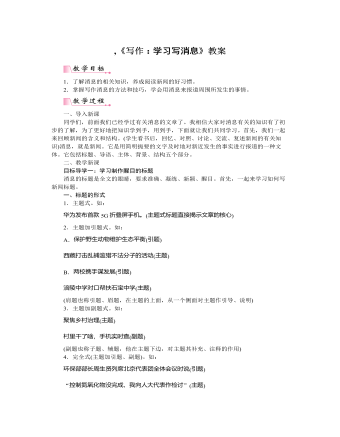
部编版语文八年级上册《写作:学习写消息》教案
1.叙述式:用摘要或综合的方法,对消息中最新鲜、最主要的事实作扼要的叙述。2.描写式:对消息中的主要事实或某一个有意义的侧面、细节,作简洁朴素而又有特点的描写。3.评论式:对所报道的事实,作简洁、精辟的评论,以揭示事件的意义和目的。4.提问式:把主要事实用提问的方式写出来,使报道的问题更为尖锐,以引起读者的注意。目标导学三:展开丰实的主体主体是消息的躯干,是对导语内容的展开和补充。其结构形式有两种:1.先后顺序。即按事物发展的先后顺序安排层次。2.逻辑顺序。即按事物的逻辑关系(如因果、并列、主次、点面等关系)安排层次。目标导学四:介绍背景和结语消息的背景和结语是一篇消息中可有可无的内容。1.背景是指消息所报道事实的历史情况和环境条件。消息使用的背景材料一般有三类:(1)对比性的;(2)说明性的;(3)注释性的。2.结语结语是消息的最后一句话或者一段话。有的消息已经把事实说清楚了,就不需要结语了。常见的结语有三种形式:(1)概括小节式;(2)预测趋势式;(3)提出问题式。





















